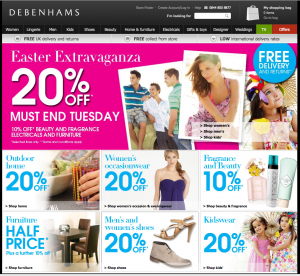For the first time in history, the customer is ahead of the retailer. This is according to Simon Forster, Divisional Director, Online, Debenhams, who understands the challenges of bringing a company that’s been around for 200 years into the digital age.
Companies like his have to start thinking differently. That’s just what Debenhams is doing…but getting there wasn’t necessarily easy. One of the most important things in turning Debenhams into a multi-channel retailer, said Forster, was to get the organization to understand that “Internet” is not a separate business unit. Believe it or not, that’s not an easy concept to sell. Hear Forster talk about how he did it and why he thinks it’s crucial that new employees leading the digital charge have product knowledge above “Internet knowledge.”
Forster will speak at eTail Europe which takes place in London from 20-22 June. You can visit the website to learn more about the program. Listen to the podcast here, but the story continues below…
According to Forster, the key thing to remember when transitioning from a traditional retail model to a more dynamic, multi-channel model is that customers want to trade in a multichannel way. “That’s a fundamental change – we’ve never seen that change before in retail,” he said. According to Forster, the company must be bought into the concept before going any further with plans to expand its channel marketing strategies. The biggest challenge, he said, is about completely changing the way the Internet is viewed internally, and the way the buying teams think about it. Here are his top strategies that he advises businesses implement in such a major thought shift:
1. Decide what resources you’re going to dedicate to the new multi-channel team. Forster joined Debenhams only 18 months ago and with his new position, he was able to determine how to develop a multi-channel business model from a blank sheet of paper. After analyzing the structure and company culture, it was clear that Debenhams needed to increase the size of its team with key appointments. The company introduced four new trading managers to concentrate on product areas like home, men’s, beauty and more.
2. Understand that the Internet is not a Scary-techy-monster. “First thing for me was to impress on business that the Internet isn’t a ‘technical’ channel; it’s a channel customers want to use and buy through,” he said. “We looked to recruit people into the Internet part of business who had great product knowledge and were really good at putting the right product in front of the customer. The people we brought in didn’t know anything about the Internet – they brought their product skills.”
Forster deliberately recruited people from the heart of business who had deep product knowledge and understanding to act as “agents of change.” They talked about the Internet in a way that other internal parties could understand.
Also, Forster noted that the company has to start understanding that every sale is a company sale, even if and when those sales are credited back to different parts of business teams. This is very important, he said, because customers don’t use the Internet on its own – they browse, then go to the store, etc. It’s NOT a separate business, he said.
“The most successful retailers are those that embrace multichannel,” said Forster.
3. Communicate often and in person. “You can’t get the organization to change by sending them an email,” said Forster. “You must make sure the message is something everybody is hearing consistently and face to face. Don’t email if you can call, don’t call if you can speak face to face. It’s a real mission to do this.”
4. Take Risks. Debenhams asked its customers whether they wanted to engage with the brand on the mobile channel at the beginning of 2010 and the desire to have better mobile interaction was number 100 on their list. Debenhams didn’t listen to them. Instead of neglecting the channel, they assumed that their customers didn’t really know they wanted a better mobile experience, but they would want it if given it. So the company produced an iPhone app and then when they surveyed their customers again, it came up within the top 10 things that customers wanted from the brand.





Recent Comments